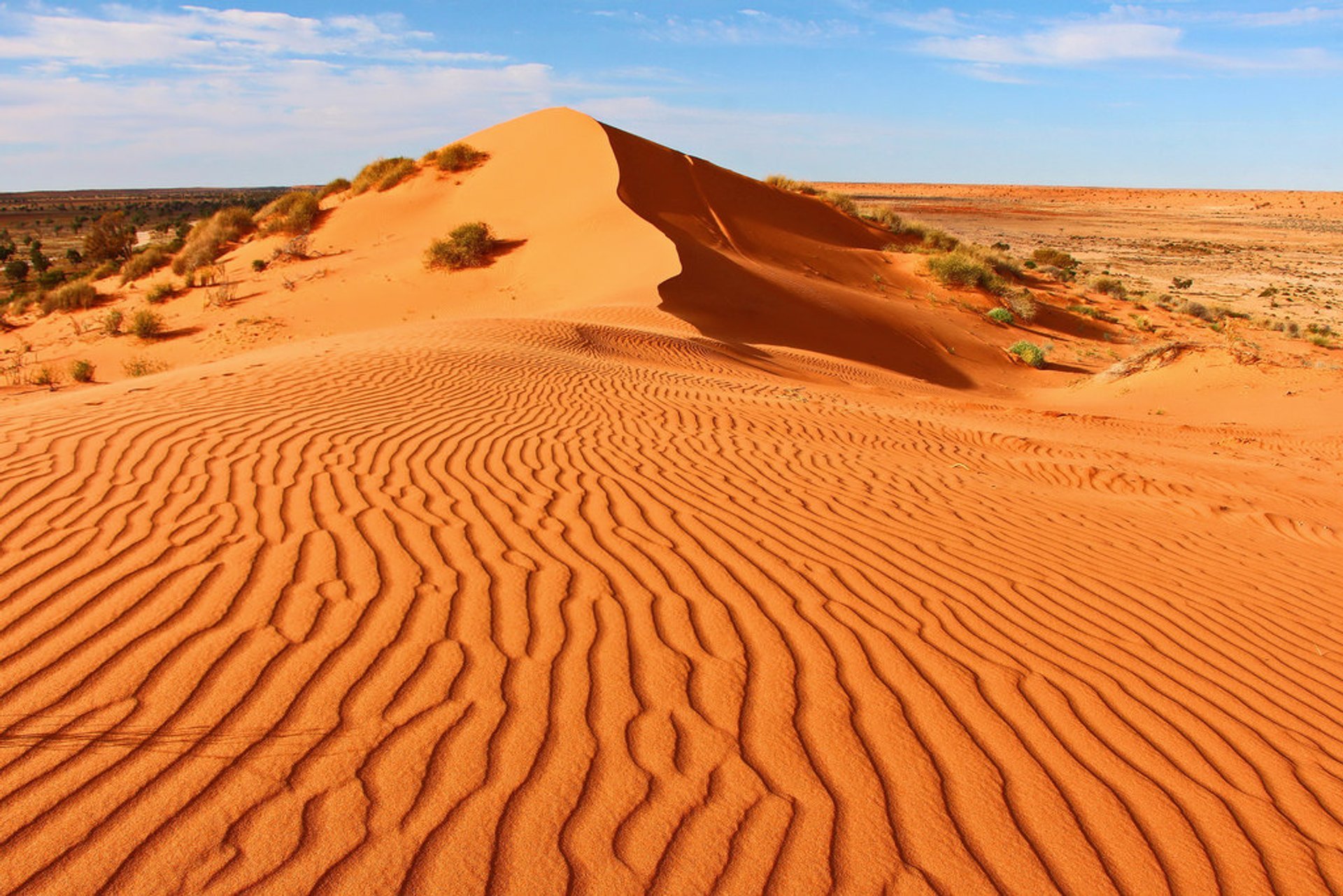Australian sand dunes stand as breathtaking icons of both natural wonder and cultural depth, stretching across arid deserts, pristine coasts, and remote wilderness. These stunning landscapes, shaped by millennia of wind and time, form some of the most visually captivating environments on Earth. From the towering red dunes of the Simpson Desert to the sparkling white sand hills of Lancelin, Australia’s dunes vary dramatically in color, scale, and ecosystem. Their majestic formations have long attracted travelers, scientists, and adventurers alike. According to Geoscience Australia, these dunes are not only geological masterpieces but also vital parts of Australia’s environmental systems, influencing climate, flora, and fauna.
Beyond their sheer beauty, Australian sand dunes host unique and resilient ecosystems. Plants such as spinifex and dune wattles thrive in extreme conditions, stabilizing the landscape while providing shelter and food for reptiles, birds, and insects. The Department of Climate Change, Energy, the Environment and Water notes that dune ecosystems serve as key habitats for several endangered species. Meanwhile, microbial communities in the soil play a critical role in preserving the health and integrity of dune systems, a fact documented by CSIRO, Australia’s national science agency.
These ancient landscapes also carry profound cultural meaning. To Indigenous Australians, sand dunes are not merely scenery but sacred spaces woven with Dreamtime stories and ancestral knowledge. In regions like the central desert, dunes are tied to creation myths and are used for hunting and gathering. AIATSIS, the Australian Institute of Aboriginal and Torres Strait Islander Studies, highlights how traditional custodianship and contemporary Indigenous ranger programs have helped protect these areas for generations. Projects supported by the National Indigenous Australians Agency further amplify efforts to safeguard these culturally rich sites.
Recreation in the dunes has boomed in recent years, turning them into outdoor playgrounds for thrill-seekers and eco-tourists. Locations such as Stockton Beach and the Big Red dune attract tens of thousands of 4WD drivers, sandboarders, and photographers each year. The rise in adventure tourism is documented by Tourism Australia, which reports a growing interest in desert and coastal dune experiences. At the same time, organizations like Parks Australia are working to strike a balance between access and sustainability.
Preserving the delicate equilibrium of these environments remains crucial. As per WWF Australia, unregulated tourism, invasive species, and climate change pose serious threats to dune stability. In response, government bodies and NGOs are investing in ecological monitoring, restoration programs, and public awareness campaigns. Initiatives such as the National Landcare Program have been instrumental in funding restoration efforts and promoting responsible land management practices in dune-rich areas.
In essence, Australian sand dunes are more than just natural spectacles — they are living systems, cultural archives, and canvases of adventure. Whether viewed through the lens of ecology, spirituality, or recreation, these awe-inspiring formations reveal the complexity and richness of Australia’s natural heritage.
The Majestic Landscapes of Australian Sand Dunes
Iconic Dune Locations Across Australia
From the immense dunes of the Simpson Desert to the coastal beauties of Lancelin, Australian sand dunes represent some of the most diverse landscapes in the world. The Simpson Desert spans 170,000 square kilometers and hosts the world’s longest parallel sand dunes. Meanwhile, Lancelin in Western Australia draws thousands of tourists annually for sandboarding and off-road adventures.
Natural Formation and Geological History
Australian sand dunes have formed over millions of years through the interaction of wind, water, and vegetation. The oldest dunes, found in the Simpson Desert, date back over 30,000 years. The process of aeolian transport — where wind shifts and piles up sand — is the primary mechanism shaping these landscapes.
Colors and Composition of the Dunes
The color of Australian sand dunes varies dramatically, from bright white silica dunes in Queensland to red ochre sands in the Northern Territory. The red hue of central dunes is due to high iron oxide content. For example, the Big Red dune near Birdsville rises to a height of over 40 meters and is composed primarily of fine, iron-rich sand.
Weather Patterns and Shifting Landscapes
Due to strong wind systems and climate changes, Australian sand dunes are constantly shifting. Dune migration in arid regions such as the Great Victoria Desert can reach up to 1 meter per year. Rainfall patterns also influence dune stabilization; the average annual rainfall in desert dune regions is below 250 mm, keeping the dunes active and mobile.
Visual Appeal and Tourism Growth
Tourism to sand dune locations has increased by 25% over the past decade, according to Tourism Research Australia. Sites like the Pinnacles Desert and Fraser Island’s dunes attract photographers and nature lovers seeking Australia’s raw natural beauty. Australian sand dunes remain a powerful symbol of the country’s unique and expansive terrain.
Australian Sand Dunes in Global Context
Compared to other global dune fields, such as those in Namibia or the Sahara, Australian sand dunes are notable for their diversity and extent. Australia holds over 20% of the world’s mobile dunes. This vast coverage underscores the importance of preserving these geological wonders for future study and eco-tourism.
Challenges of Preserving Natural Landscapes
Despite their beauty, Australian sand dunes face challenges from off-road vehicles, mining, and invasive species. In regions like Stockton Beach, vehicle activity has led to significant erosion. Conservation programs supported by the Australian Government’s National Landcare Program have funded over $12 million for dune restoration since 2015.
Biodiversity and Ecosystems Within the Dunes
Unique Flora of Dune Environments
Australian sand dunes host specialized plant species like spinifex, acacias, and banksias. These plants adapt to poor nutrient conditions and shifting substrates. For instance, Spinifex sericeus plays a crucial role in stabilizing coastal dunes and preventing erosion, thriving in areas with annual rainfall below 400 mm.
Rare and Endemic Fauna
Dunes are home to a range of species including the sand goanna (Varanus gouldii), the lesser hairy-footed dunnart (Sminthopsis youngsoni), and the wedge-tailed eagle. In Western Australia alone, over 120 species of reptiles are found in dune ecosystems. These species depend on the sparse vegetation and burrowing opportunities provided by the dunes.
Microbial Life and Soil Health
The topsoil of Australian sand dunes harbors resilient microbial communities. Research by the CSIRO shows that bacterial colonies in arid dune systems can survive temperatures above 50°C and contribute to soil crust formation, which reduces erosion. These microbes play a vital role in maintaining ecosystem stability.
Migratory and Nesting Birds
Several coastal sand dunes serve as nesting grounds for migratory birds like the hooded plover and eastern curlew. According to BirdLife Australia, populations of the hooded plover are estimated at fewer than 3,000 nationally, with many nesting sites located in dune habitats under threat from human disturbance.
Invertebrates and Pollinators
Dune ecosystems also host diverse invertebrate life, including dune beetles, ants, and pollinating insects. These organisms contribute to the ecological web by enhancing plant reproduction and nutrient cycling. Studies in Queensland dune systems have recorded over 200 species of beetles alone.
Impact of Invasive Species
Invasive plants like bitou bush and animals such as rabbits have disrupted native dune ecosystems. Management efforts have reduced bitou bush infestation by 60% in targeted New South Wales dune reserves through controlled burning and herbicide use since 2010, according to environmental monitoring reports.
Conservation and Ecological Monitoring
Ongoing monitoring by the Australian Government includes biodiversity surveys and remote sensing in key dune systems. Protected areas like Coffin Bay National Park help preserve the integrity of these ecosystems. Australian sand dunes are vital not only for their scenic beauty but for the fragile life systems they support.
Cultural Significance of Sand Dunes to Indigenous Australians
Spiritual Meaning and Dreamtime Stories
For Indigenous Australians, Australian sand dunes are not just landforms — they are sacred spaces imbued with spiritual meaning. Many dunes are tied to Dreamtime stories, such as those of the Arrernte people in Central Australia, where dunes are believed to be the resting bodies of ancestral beings.
Traditional Land Use and Practices
Dunes were used by Indigenous communities for shelter, food gathering, and ceremonial events. The shifting sands provided cover and visibility for tracking animals. For example, the Martu people of Western Australia used the dunes for hunting goannas and collecting seeds used in traditional foods.
Art, Symbols, and Cultural Expression
Many Aboriginal artworks include patterns that reflect the flowing lines of dunes. Dot paintings often depict dune formations as spiritual pathways. The Papunya Tula artists, for instance, frequently incorporate sand dune motifs to represent journeys and ancestral routes across the desert landscape.
Place Names and Language
Dune features have distinct Indigenous names that preserve linguistic and cultural heritage. In the Pitjantjatjara language, the term “tali” means sandhill. Preserving these names is vital; Australia has over 250 Indigenous languages, many of which are at risk of disappearing.
Modern-Day Custodianship
Indigenous ranger programs have become a key part of dune conservation. The Indigenous Protected Areas (IPAs) program covers over 76 million hectares, including many sand dune regions. These programs employ over 2,500 Indigenous rangers to manage land using a blend of traditional knowledge and modern science.
Cultural Tourism and Education
Cultural tourism initiatives allow visitors to learn about Indigenous connections to Australian sand dunes. Guided walks and storytelling experiences on dunes near Uluru and Broome attract thousands each year. According to Tourism Australia, cultural tourism contributed over $7.4 billion to the economy in 2023.
Threats to Cultural Sites in Dunes
Unfortunately, dune erosion, mining, and off-road tourism can damage sacred sites. The Juukan Gorge incident in 2020, though not on a dune, spotlighted the need for better cultural protections. Similar dune sites are now being reassessed under updated heritage laws in Western Australia and the Northern Territory.
Adventure and Recreation: Exploring the Dunes
Sandboarding and Dune Surfing
Sandboarding is one of the most popular activities on Australian sand dunes. Lancelin, located an hour north of Perth, offers dunes reaching up to 30 meters. Boards can reach speeds of 70 km/h. Over 50,000 tourists try sandboarding in Lancelin every year, according to local tourism boards.
4WD and Off-Road Excursions
The dunes in places like Stockton Beach and the Simpson Desert are ideal for 4WD adventures. Over 3,000 km of off-road trails exist in dune-rich areas of South Australia and Queensland. Safety guidelines and permits are required, and many areas offer guided expeditions to protect the environment.
Camel Treks and Desert Experiences
Camel rides across dune areas near Uluru and Alice Springs offer a unique way to explore the desert. The Uluru Camel Tours company reported over 20,000 riders in 2023. These experiences often include cultural briefings and sunset views of the iconic red dunes.
Hiking and Photography
For those on foot, dunes offer incredible photo opportunities. Dunes like the Pink Dunes in Victoria’s Sunset Country change color with the light, making them a favorite for landscape photographers. Hiking tours are often limited to cooler months due to temperatures exceeding 45°C in summer.
Camping and Stargazing
The remoteness of Australian sand dunes makes them perfect for stargazing and overnight camping. According to the International Dark-Sky Association, areas like Arkaroola in South Australia offer some of the darkest skies in the southern hemisphere. Visitor numbers for camping in dune parks increased by 18% between 2021 and 2023.
Eco-tourism and Guided Tours
Many tour operators now emphasize low-impact travel. Eco-certified tours in dune environments focus on conservation and education. The Ecotourism Australia certification program has registered over 1,400 sustainable operators, including many working in dune landscapes.
Safety and Environmental Guidelines
Dune recreation comes with responsibilities. Visitors are advised to follow “leave no trace” principles and stay within marked zones. Government reports show that 15% of dune degradation is caused by unauthorized vehicle use. Australian sand dunes can provide thrilling experiences, but sustainable practices are crucial to their longevity.




